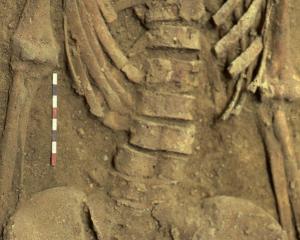
Through the moon-gate of the Chinese garden, we come upon many facets of Chinese culture: its art, poetry and painting, its music, architecture and people.
In the West, we talk about house, garden and fine arts as distinct from one another. In China, all these aspects of culture were expressed within the word for garden, yuan.
Private gardens emerged during the late Han Dynasty (about AD200) as a completely separate style from the earlier great hunting parks of the emperors.
They reached their zenith in the Ming Dynasty (1368-1644). The ravages of civil war and later the Cultural Revolution took their toll in the 20th century, but many are now restored and open to the public in the great garden cities south of the Yangtze River: Suzhou (‘‘Venice of the East''), Hangzhou, Wuxi, all near Shanghai.
Today, with an affluent and visible Chinese diaspora, new gardens in the traditional style are being faithfully re-created throughout the world.
In New Zealand, we have fine Chinese gardens in Hamilton, Hastings, Nelson, New Plymouth and Oamaru, with others being built in Dunedin and Timaru; Wellington and Auckland are in the planning stage.
One of the names for China is Zhonghua Guo, which means ‘‘Central Flowery Kingdom''.
Compared with the plethora of plants from China in New Zealand garden centres, there is, ironically, relatively little plant variety in the traditional Chinese garden.
The aim of the Confucian scholar-officials who devised these gardens was not to collect plants but to design a space which ‘‘nourished the heart'' and ‘‘created an atmosphere of deep feelings''.
The inspiration for the traditional Chinese garden came from Daoist (Taoist in the old spelling) hermits 2000 years ago.
They went up to the mountains, ever a symbol of awe and spiritual dominance in Chinese thought, and meditated upon nature and the human condition as part of it. They watched and revered the passing of the seasons, and they painted and wrote poetry about the great vistas they loved.
The three great philosophical traditions in China are Confucianism, Daoism and Buddhism.
While historically Buddhism was the major religion in China, the Confucian code of ethics governed social conduct.
Daoism, with its esoteric doctrine, inspired the Chinese pseudo-sciences of alchemy and geomancy and later developed as a popular religion.
All three contributed to the principles governing Chinese garden design.
Confucianism
The essential idea of the garden as a microcosm of natural landscape came directly from Daoism, but the men who created the gardens were all Confucian scholars, administrators in the imperial government, referred to as scholar-officials.
Most of them were wealthy landowners in their own right, but not all; any man who could pass the state examinations in the Confucian classics was entitled to a post in the civil service.
His term of office was often surprisingly short; corruption and connivance at court made for an average employment span of only eight years in the Ming Dynasty.
Confucius made a virtuous man of the unemployed scholar-official. He would not lose face when he lost his job, Master Kong instructed in his Analects, indeed, ‘‘a gentleman finds recreation in the arts''.
Referred to as the Amateur Ideal, this tradition encouraged the scholar-official to be a jack of all arts, to take the wealth he earned from his time in office back to his home town and create a garden that was both a work of art in itself and a place for the pursuit of excellence in the classical arts: writing poetry, doing calligraphy, painting landscapes, playing chess, arranging flowers, playing the lute.
The Yuan Ye (‘‘Gardensmith''), written in 1634, is the only book in the entire corpus of Chinese literature specifically on garden design. It's a treatise on the scholarly garden and on the Amateur Ideal.
It doesn't offer step-by-step rules for garden design, but it guides the scholar in his own expertise and style within Confucian constraints.
An important Confucian contribution to garden design is allusion. References to the classics of antiquity are everywhere in the garden, as rhyming couplets framing doorways, as titles for pavilions, or naming a view.
Confucius put man at the centre of the universe, so Confucians brought the human element into the garden: its close proximity to the extended family, its many buildings for various cultural functions and the location of the garden - usually in an urban centre.
Daoism
Lao Tze, the reputed founder of Daoism, lived about 500BC, at the same time as Confucius. Lao Tze's great work was the Tao Te Ching.
‘‘Dao'' means ‘‘The Way'', and the Daoist Way advocated harmony with nature, not dominance over it.
The Dao promoted a love of natural landscape to be revered in all seasons. ‘‘Wu Wei'', the Daoist principle of not tampering with things or taking forced action, manifests in the garden in soft, fluid lines, the natural contours of the wild landscape.
The Daoist garden must contain elements of the natural cosmos: mountains and caves, water and trees.
If a man wasn't able to ramble among the hills and streams of the countryside or meditate in a cave - and few could - the next best thing was to have them in his garden, which included pavilions for watching the moon rising, contemplating fish, and delighting in reflections.
The Daoists worshipped stone as the best symbol of immortality. There was the belief that the immortals themselves lived in the mountains in caves or grottos under the earth. The Chinese gardens included grottos to attract visitations from these spirits.
In the Tang Dynasty (AD618-907), this reverence for stone reached absolute mania as emperors constructed huge rock mountain landscapes in their parks.
Confucian scholar-officials emulated the scenes in miniature. In their gardens we can see carefully constructed rock mountains, caves and grottos.
And in their courtyards, fabulous stones as statues, usually limestone full of holes and crinkles, and as valuable as a Henry Moore or a Naguchi in the West.
In some Chinese gardens the dominance of rock is quite overwhelming to Western sensibilities.
The Daoist principle of yin and yang, the duality of opposites, is critical in the planning of a Chinese garden. Yin is the feminine principle: dark, yielding, for example, water.
The masculine principle, yang, is manifest in the rocks around the water's edge or the burst of sunlight leading out of a shady courtyard (the shade would be yin).
Geomancy is a Daoist quasi-science. We know it as feng shui, which means ‘‘wind and water''. To the Chinese, a garden building site is not just an empty space; it is known to manifest certain properties that influence the fortunes of those who use the site.
The prevailing winds, the lay of the land in relation to the flow of water through it, and the electro-magnetic forces on a site must all be deemed favourable.
Feng shui enjoys enduring credibility in Chinese thought and planning. The geomancer would have been one of the first employed to scrutinise the Dunedin garden site.
Buddhism
Buddhism arrived in China from India in the third century.
The Buddhist doctrine of ahimsa condemned violence and thus protected every living thing within the monastic compound.
Buddhist monasteries were established in beautiful natural settings, and they gave impetus to the taste for private scholar gardens that developed after the fall of the Han Dynasty (AD221).
Buddhist monks were the first to cultivate many of the garden plants typical of Chinese gardens: magnolia, ginkgo, tree and herbaceous peonies, camellias.
The ginkgo was saved from extinction by monastic protection, and its fruit was prized by the vegetarian monks.
The lotus, Buddhist symbol of purity found in every classical garden in China, owes its popularity to the monks who knew of it in Indian Buddhist art.
The tea plant, Camellia sinensis, was also a Buddhist discovery used to promote wakefulness during long periods of meditation.
The most popular garden plants and trees are symbolic of human virtues, or they glorify a specific season.
- Diana Madgin is a garden writer and tour guide in Christchurch. She and her husband, sinologist Prof Bill Willmott, take garden tours to China.












